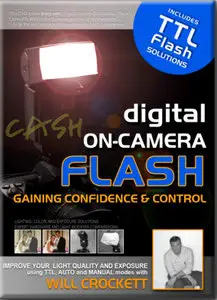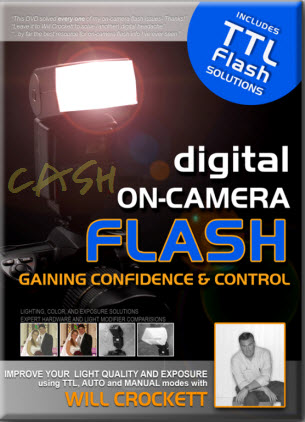April 2024
| Su | Mo | Tu | We | Th | Fr | Sa |
|---|---|---|---|---|---|---|
| 31 | 1 | 2 | 3 | 4 | 5 | 6 |
| 7 | 8 | 9 | 10 | 11 | 12 | 13 |
| 14 | 15 | 16 | 17 | 18 | 19 | 20 |
| 21 | 22 | 23 | 24 | 25 | 26 | 27 |
| 28 | 29 | 30 | 1 | 2 | 3 | 4 |
Digital On-Camera Flash Gaining Confidence and Control
Date: 2 Oct 2009 19:48:16
Better light quality, color and exposure using any flash in AUTO, MANUAL or TTL exposure modes. In this video, we improve the light quality of the biggest troublemaker in the digital photo world, on-camera flash with digital expert Will Crockett. The good news is that we now have a wide variety of flash tools to make some terrific images quickly and profitablty. But the bad news is that some of the digital camera and flash systems don't quite work as advertised. So let's take look at the problems most photographers face when shooting with on-camera flash, then a variety of solutions to fix or just deal with the problem and make the best photos possible. Digital On-Camera Flash Gaining Confidence and Control DVD presented by Will Crockett
Chapter ONE:
PROBLEMS AND SOLUTIONS
The first goal of this video is to guide you to the right way to use the tools you already have. The second goal is to show you how to create better quality light for all your OCF shooting situations. Both have their own series of problems we need to solve.
Chapter TWO:
CHOOSING LIGHT QUALITY
The end result (a nice picture) is much more important that how you got there, so let’s take a glimpse at what we can do as far as the look and feel of our OCFlash images so we can decide what type of photographic light quality we want.
Chapter THREE:
INDOORS vs. OUTDOORS
How ‘bout we take a quick review of the light quality choices we have for indoors and outdoors?
Chapter FOUR:
EXPOSURE ISSUES EXPOSED
No matter which type of light modifer we choose, we need to keep it in control with regard to exposure.
Chapter FIVE:
EXPOSURE MODES: A AA, TTL, AUTO, MANUAL
We have three basic types of controlling exposure in the OCFlash world: Manual, AUTO and TTL. Each has their place in professional photography, but where and when?
Chapter SIX:
TTL EXPOSURE MODES
There has been a TON of technology poured into the TTL systems in the past few years. Each new TTL camera and flash gets better and better, but we cannot rely on TTL to make all of our exposure decisions unless we discover where TTL fails. Here’s how to make your TTL system work better.
Chapter SEVEN:
MANUAL EXPOSURE MODE
Some photographers don’t have the patience nor tolerance for automated exposure systems that cause trouble. Instead, they take the old-school manual exposure route and shoot JPEGS with exposures as tight as a drum. We’ll show you how they do it.
Chapter EIGHT:
AUTO EXPOSURE MODE
Resting comfortably between TTL and manual exposure methods is auto exposure. Auto mode does a respectable job and is the cornerstone to many successful OCFlash shooters who rely on JPEG exposure tolerances for their bread and butter. Let’s take a closer look?
Chapter NINE:
CHOOSING THE RIGHT MODE AND MODIFIER FOR YOU
Wow, TTL, AUTO, MANUAL modes, direct, diffused, bounce bounce+direct. How are you going to choose the right system for your OCFlash images? Let’s make it easy by narrowing down the choices you have to look at.
Chapter TEN:
HARDWARE: CHOOSE THE RIGHT TOOL FOR THE JOB
There is nothing worse to a photographer than not having the right tool for the job, or worse, having the wrong tool for the job. Here’s our top performing flashes and (in our opinion) the only ones you should be using.
Chapter ELEVEN:
SHOOTING VERTICAL IMAGES
We all need to flip between shooting horizontally and vertically. But once we get your flash and light modifiers set, how can we just turn them sideways and get good light? Here’s some tips.
Chapter TWELVE:
USING TWO LIGHTS
So many photographers ignore a second flash because they think it’s too much work and effortor it’s just not worth it, but let me show you some neat ideas for making your flash images so much more appealing than your competitions images?
Chapter THIRTEEN:
WIRELESS TRIGGERING
So how are we going to trigger these single and two light shots? Simple. We have a few different ways that work well.
Chapter FOURTEEN:
THE IMPOSSIBLE TASK
Keeping an eye on technology pays off.
Download full movie Digital On-Camera Flash Gaining Confidence and Control



